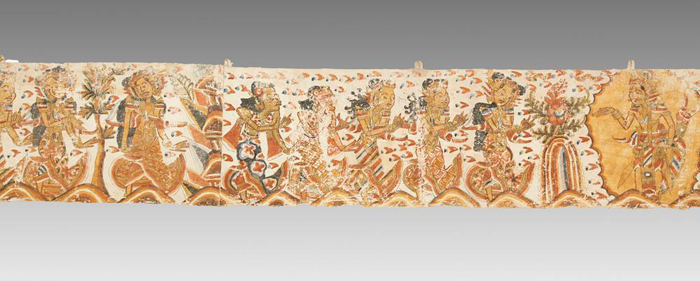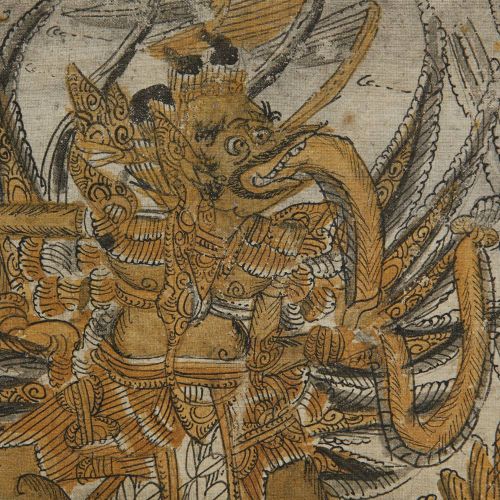Traditional Narrative Art - Balinese Temple Paintings
PRIMITIVE - Friday, June 30, 2017By Glen Joffe
 |
|
Although the fragrance of flowers is everywhere, something else fills the air. I am under some sort of spell and cannot resist, but I was warned, “Bali is a trance island.”
The island of Bali is in Indonesia. While it can be described as an island paradise featuring extraordinary natural vistas and scenes of great beauty on both a grand and intimate scale, it is also home to one of the most complex and engaging cultures in the world. While the rest of Indonesia is Islamic, Bali is Hindu. However, Hinduism as practiced on Bali is endemic to the island alone. It is a mixture of traditional Hinduism as it is found in India, Buddhism, ancient animistic beliefs and magical practices prevalent among the Balinese themselves. Short on transparency and long on ritual, religion on Bali is filled with Hindu and Buddhist gods and demi-gods, culture heroes, mythological creatures, demons, personages from great epic poems, countless ancestral spirits, and local deities. All these are woven together into a complex system pervading every aspect of Balinese life.
 |
|
All the religious beliefs of the Balinese are interwoven with the art and ritual found on the island. In short, it is impossible to separate the art of Bali from the religious practices of the Balinese people. Everywhere you look on the island, art and religion are in service to each other. It is impossible to walk the streets of any village, large or small, and not walk by temples or avoid small offering baskets laid on the ground and filled with flowers and rice. On any given day, processions of temple members will be seen proceeding along the roadside toward one or another of the estimated 20,000 temples found on the island; the women carrying baskets of offering food on their head, just about everybody dutifully dressed in Balinese finery. The Balinese say that to be Balinese is to be a member of at least three temple communities; and to be a member of any one of these communities requires participation in a range of festivals held at regular intervals. For these festivals, women prepare the offerings and men are responsible for decorating the temple. Lack of participation in these festivals is the equivalent of losing one’s religion, culture, status, and inclusion in Balinese society as a whole.
 |
|
One of the most important types of decoration found in Balinese temples is a distinct type of narrative art - paintings telling stories related to religion, cosmology, mythology and everyday life. In essence, these paintings illustrate epic poems and folk tales. The major stories illustrated in traditional Balinese temple paintings are derived from the Indian epic poems the Ramayana and the Mahabharata; and the Indian Jataka tales, which relate to the various incarnations of Buddha in both human and animal form. Yet, purely Indonesian stories exist as well; specifically, the Panji, which relate the stories of a Javanese prince, and the Tantri stories, which include numerous tales of animal folklore. Despite the distinctive nature of Balinese religion, there is really only one version of the Hindu and Buddhist stories known to Balinese artists compared to India, where multiple versions exist. Story lines aside, the interpretation of all these tales may vary from one priest, villager or artist to another. All these narratives provide the wellspring for traditional Balinese temple paintings.
 |
|
Traditional Balinese temple painting is not meant to express the personal viewpoint of the artist as in western painting, contemporary and otherwise. Virtually all traditional Balinese temple paintings remain unsigned by the artists responsible for their creation. This type of painting is ceremonial and functional rather than commercial and decorative; its creation as much an act of devotion as a reflection of individual talent. While traditional Balinese temple paintings may be used as teaching tools for the young and to express various life lessons, just about all these paintings are meant to reveal the Niskala, the unseen world as it is known to Balinese artists. In the Niskala, Hindu gods and goddesses live, numerous heroes and demons are found, ancestral spirits reside, all manner of legends arise, and countless folk tales find expression. These paintings were not meant to be objects of contemplation; for example, as might be found in Christian icons or Buddhist Thangkas. The viewing of the actual paintings might be partly obscured by offerings of food and flowers and the actions of the priests and congregation, who were not benign in their ritual and festival participation. In just about all instances, they were intended to be part of a larger, more complex narrative involving entire buildings and the compounds they decorated, all intended to initiate individuals into traditional Balinese religion and society.
 |
|
As noted, traditional Balinese artists rarely sign their work because these works are not considered decorative expressions of individual perspectives, but instead, personal expressions of devotion to the lessons taught in individual stories. In other words, what is being conveyed supersedes who is doing the conveyance. One prominent idea in the creation of these paintings is the artist is really the agent of a higher power called taksu, which may also be viewed as divine inspiration. Most artists creating traditional Balinese temple paintings regard themselves as the vehicle of taksu and cannot take credit for their individual work. They may pride themselves in a specific creation, but not in the hope of a sale or even a compliment on the quality of their art. Rather, the individual creation is seen as a contribution to the temple on the part of the artist.
 |
|
 |
|
Traditional Balinese temple paintings fall into five distinct categories and are classified by use, not content. They are: 1) Tabing; essentially square or large rectangular paintings used as backdrops in temple pavilions against which offerings may be placed. These types of paintings usually display important narrative scenes. Included among Tabing are the distinctive Balinese astrological calendars known as Palelintangan. 2) Langse; paintings used as curtains to screen the area in the temple where the offerings are placed. They may also line walls. 3) Ider-Ider; long horizontal hangings, essentially valances, in typical use designed to go outside the temple. As narrative art they can be compared to strip cartoons since they tell the story in a progressive manner. They are meant to be read by the viewer as they walk around the building. 4) Ceiling Paintings; meant to go at the top of the pavilion above the platform holding all the various offerings. As a result, subjects are typically centrally organized at the center. 5) Kober and Lontek or flags and banners; used outside and thus subject to rapid deterioration. They are normally painted on both sides in the mirror image of the other. Plain or printed cloth could also be used in lieu of painted cloth.
 |
|
Whereas Ider-Ider display a sequence of events illustrating them scene by scene; Tabing, Langse and Ceiling Panels largely show one scene or a composite of scenes from a particular tale. Flags and banners feature characters from stories. Although Balinese culture has accepted many influences from the outside world and made them distinctly Balinese, traditional Balinese temple painting is one area that has remained largely unchanged for centuries. These paintings represent a window into Balinese religion and the Balinese worldview, which is laden with influences from the Niskala. The Niskala is invisible, present and timeless; however, it is exposed through the art of traditional Balinese temple painting. Exposure to these paintings makes the ethereal physical and what is inherently invisible, visible. Other painting traditions are present in Bali, but traditional Balinese temple paintings are created for non-commercial purposes and transcend purely decorative art. Their creation is nourished by the Niskala and tempered by taksu. While their affect on the viewer is mesmerizing, they are part of the reason Bali is known as a “trance island.”